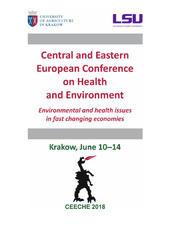Prikaz osnovnih podataka o dokumentu
APPLICATION OF IN VITRO AND IN SITU BIOASSAYS FOR EVALUATION OF WATER GENOTOXIC POTENTIAL
| dc.creator | Đorđević Aleksić, Jelena | |
| dc.creator | Jovanovic, J. | |
| dc.creator | Kolarevic, S. | |
| dc.creator | Miloskovic, A. | |
| dc.creator | Radojkovic, N. | |
| dc.creator | Simic, V. | |
| dc.creator | Dojcinovic, B. | |
| dc.creator | Kracun-Kolarevic, M. | |
| dc.creator | Paunovic, M | |
| dc.creator | Kostić-Vuković, Jovana | |
| dc.creator | Sunjog, Karolina | |
| dc.creator | Timilijic, J | |
| dc.creator | Gačić, Zoran | |
| dc.creator | Zegura, B | |
| dc.creator | Vukovic Gacic, B | |
| dc.date.accessioned | 2023-10-17T11:04:40Z | |
| dc.date.available | 2023-10-17T11:04:40Z | |
| dc.date.issued | 2018 | |
| dc.identifier.uri | http://rimsi.imsi.bg.ac.rs/handle/123456789/2152 | |
| dc.description.abstract | Human activity has the great negative impact on water quality. As a consequence, deterioration of freshwater ecosystems has the effect on whole wildlife. Some of the pollutants which are realised into water could interact with DNA molecule and lead to DNA damage. The Velika Morava River is one of the larger tributaries of the Danube River. The major ecological problem of the Velika Morava River basin is discharging of municipal and industrial wastewaters. The aim of our study was the evaluation of genotoxic potential of the Velika Morava River basin. For this purpose, we employed battery of in vitro and in situ bioassays. From 9 selected sites the water samples and blood samples of Alburnus alburnus were collected. Within in vitro approach, the genotoxicity of water samples was tested using the SOS/umuC test on Salmonella thyphimurium TA1535/pSK1002 and alkaline comet assay on the HepG2 cell line. On the other hand, in situ approach included the alkaline and Fpg modified comet assay and the micronucleus test on bleak (A. alburnus) erythrocytes. The obtained results indicated differences of in vitro and in situ tests to evaluate genotoxic potential. The effects of genotoxicity were evident only in tests performed in situ, which is not surprising considering constant exposure of collected organisms to environmental stress. Differential sensitivity was found also within in situ tests where the alkaline comet assay showed the highest potential in distinguishing between sites. So, in accordance with results, we could conclude that application of the battery of in vitro and in situ bioassays is appropriate for assessment of genotoxic potential. | sr |
| dc.language.iso | en | sr |
| dc.publisher | University of Agriculture in Krakow | sr |
| dc.publisher | Louisiana State University | sr |
| dc.rights | openAccess | sr |
| dc.rights.uri | https://creativecommons.org/licenses/by/4.0/ | |
| dc.source | Central and Eastern European Conference on Health and the Environment Krakow 2018 | sr |
| dc.subject | DNA damage | sr |
| dc.subject | wastewaters | sr |
| dc.subject | Velika Morava River | sr |
| dc.subject | Danube River | sr |
| dc.subject | genotoxicity | sr |
| dc.title | APPLICATION OF IN VITRO AND IN SITU BIOASSAYS FOR EVALUATION OF WATER GENOTOXIC POTENTIAL | sr |
| dc.type | conferenceObject | sr |
| dc.rights.license | BY | sr |
| dc.citation.epage | 59 | |
| dc.citation.spage | 59 | |
| dc.identifier.fulltext | http://rimsi.imsi.bg.ac.rs/bitstream/id/5712/bitstream_5712.pdf | |
| dc.identifier.rcub | https://hdl.handle.net/21.15107/rcub_rimsi_2152 | |
| dc.type.version | publishedVersion | sr |

